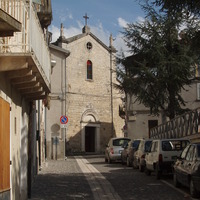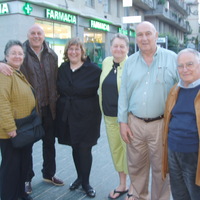 It is hard to believe, but exactly one year ago today, I was in Abruzzo with my parents. Some of you might have seen the pictures from the trip, which I posted earlier in the year. But to date, I have not written about the trip. Given my enthusiasm for genealogy, I realize that this is a bit strange. But in some strange way, it makes sense to me: I still have not fully digested the enormity of the trip. For that matter, I am not sure that I will ever fully digest the enormity day.
It is hard to believe, but exactly one year ago today, I was in Abruzzo with my parents. Some of you might have seen the pictures from the trip, which I posted earlier in the year. But to date, I have not written about the trip. Given my enthusiasm for genealogy, I realize that this is a bit strange. But in some strange way, it makes sense to me: I still have not fully digested the enormity of the trip. For that matter, I am not sure that I will ever fully digest the enormity day.
Our trip to Abruzzo had 3 legs, including a stop in Popoli, Serramonacesca and San Salvo. Our tour of Popoli was brief and and a bit disappointing. We spent most of our time walking through the old part of town, where my relatives lived before immigrating to the US. This section of the town was in a state of disrepair and felt very inaccessible (the churches were encased in scaffolding and locked; people looked at us with suspicion). The newer part of town felt generic.

After leaving Popoli, we drove to Serramonacesca hoping for (at least) a snap shot of life, as it use to be. What we got, however, was full frontal exposure. Or putting it another way: when modernity was passing out tickets, Serramonacesca was not in line.
The village was, and remains very small (approximately 600 residents, mostly elderly). The town is anchored by the Catholic Church of Santa Maria Assunta. My great grandfather was baptised in this church, and his parents were married there. The town has one municipal building, but there is no school, grocery, restaurant, or hospital. If there is a fire department, I didn't see it.

On the day we were there, there was a funeral being held in the church. Mrs. D'Orazio was being laid to rest. The entire town was at her funeral; the church is small, so many people spilled out into the street. At the end of services, her casket was put onto a cart and the priest and all the parishioners walked with the body to the cemetery. It was a very touching scene, straight out the Seventeenth Century.
After the funeral procession left, we were able to go into the church. I do not know exactly when the church was built, but I do know that the parish was part of the papal properties at the time of Pope Gregory XIII (1572-1585). I suspect that the church is much older than that, however, as the Abbey of San Liberatore a Maiella (located a little further up the mountain) dates back to the 781 AD.
When my father and I walked into the church, there was an elderly custodian cleaning up inside. It turned out that he spoke English, after many years of living in Canada. After my father struck up a conversation with him, he verified what I already knew: there are no Cervones left in Serramonacesca. He also volunteered to drive up the mountain, and open the church of San Liberatore a Maiella for us. "You can't leave without seeing it."

Our driver was flabbergasted that this old man volunteered to do this for us. "Things like this just don't happen in Italy." On one hand, I totally understood where he was coming from. Who has unfettered access to one of the oldest Medieval Churches in Italy? But on the other hand, he was thinking in modern terms, and we were in an ancient place with a old man. Our driver also failed to understand that despite outward appearances, my parents are quite provincial. In Rome (and in Manhattan), you don't talk to strangers. On the East End of Long Island, you talk to everyone. Hence my father had no reservations about speaking to this old man in the church. I realize, in hindsight, that it was actually my father who opened the door to the church.
After leaving Serramonacesca, we traveled 90 minutes (due west) to San Salvo. My great grandfather, and (at least) two of his siblings immigrated from here around the turn of the Century. His youngest brother, Vitale, was still unaccounted for.
San Salvo is a very large city (17,000 people), situated on the Adriatic Coast. Unlike Popoli and Serramonacesca, it is a very modern place which boasts both a marina and amble light industry. The condos hugging the coast line also suggested a degree of affluence that we did not see in Popoli or Serramonacesca.
 It took our driver quite a while to find parking, but he finally settled for a spot directly across from a cafe that sold gelato. It turned out that the cafe was out of gelato, so I walked outside to stretch my feet and get some air. Before I knew it, my mother was yelling from inside the cafe, "Michelle, come in here. There is someone in here that knows a Cervone." Dino Cervone, to be exact.
It took our driver quite a while to find parking, but he finally settled for a spot directly across from a cafe that sold gelato. It turned out that the cafe was out of gelato, so I walked outside to stretch my feet and get some air. Before I knew it, my mother was yelling from inside the cafe, "Michelle, come in here. There is someone in here that knows a Cervone." Dino Cervone, to be exact.
It turned out that Dino's family was originally from Serramonacesca. They immigrated to San Salvo around 1870. He also said that his grandfather's name was Vitale, and most of his family had immigrated to the New York. His grandfather visited the family several times in New York. At this point, all I could think was, "no, this just can't be.....". But Dino extinguished all of my doubt when he told me that his grandmother's maiden name was Angela Cieri. My great grandfather's brother, Vitale Antonio, married Angel Cieri in San Salvo on the 19th of November 1891. I had a copy of their marriage certificate with me.
It turned out that the man who recognized our name was married to Dino's niece, Vitalia. Vitalia and her husband asked us back to their home, and we visited with them for about one hour before returning to Rome.
When we got back into the car, the enormity of the moment was palpable. We found Vitale's grandson. Even our driver was crying. "Things like this just don't happen in Italy."